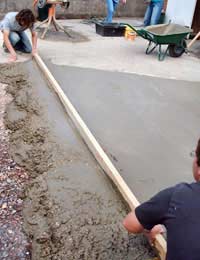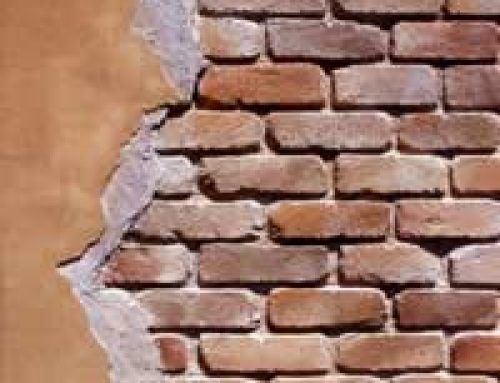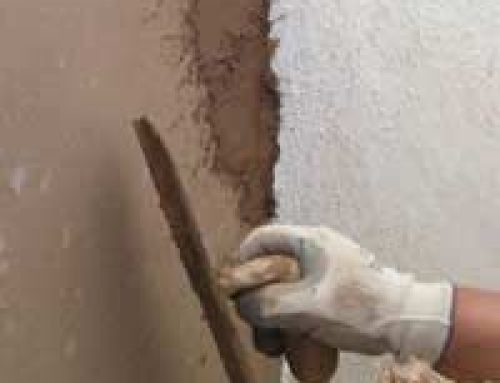
A potentially sustainable new form of concrete has been recently created that might make it the most environmentally friendly type of building material.
Concrete in its traditional form is made from cement, mixed with a range of coarse aggregates such as gravel, limestone or granite, and some finer particle aggregates such as sand or fly ash.
These are mixed together with water, to form a quick drying bonded structure, which can easily be manipulated into many forms such as the surface of roads, or driveways or footings for structures. It is the most commonly used building material in the world – some estimate that in the region of 7 cubic kilometres of concrete are manufactured each year, and that there already is 1 cubic metre of concrete for every human on earth.
Unfortunately concrete is not an environmentally friendly material, either to make, or to use, or even to dispose of. To gain the raw materials to make this material, much energy and water must be used, and quarrying for sand and other aggregates causes environmental destruction and pollution.
Concrete is also claimed to be a huge source of carbon emissions into the atmosphere. Some claim that concrete is responsible for up to 5% of the world’s total amount of carbon emissions, which contribute to greenhouse gases. This is created in the heat that is needed to create the raw cement – cement is burnt at high temperatures, and materials such as limestone must be burnt to create the high temperature.
A New Form of an Old Material
Scientists at a British concrete manufacturer, the London-based Novacem, claim to have developed a new form of concrete that effectively absorbs large amounts of carbon dioxide as it hardens. Novacem’s new version of concrete, uses a different raw material, magnesium sulphate, which requires much less heating. Novacem claim that each tonne of cement can absorb up to 0.6 tonnes of CO2. This is opposed to figures that claim that each tonne of old style cement emits about 0.4 tonnes of CO2.
For any building material to actually absorb carbon rather than just emit it in its production, is really a breakthrough, though Novacem admit the material is still in its trial period. The consequences of having an environmentally friendly building material available and on the market for builders to use, and for architects and designers to insist on using in the design of buildings and roads, is immense, and a real development for a sector which has been very guilty of creating carbon emissions through building operations.
The British Cement Association have reacted with some scepticism to Novacem’s announcement, stating that they have several non-cement alternatives being tested currently, and that there is little worldwide geological availability of other materials to create such alternative concrete, without the traditional cement. Novacem state that they estimate that there are around 10,000 billion tonnes of magnesium silicates available worldwide, and that their process could use alternative byproducts as well that also contain forms of magnesium.
Novacem is so confident of the sustainable and carbon negative potential of this new product that they have initiated a 1.5 million pounds pilot plant project in the UK, to further research this new type of concrete, experiment with it and seek the necessary licences to manufacture it. The product itself could be several years away from being available to the building public and the building trade in general, but it does have great potential, and is eagerly awaited.





i like your site, it really helps us to know about modern technologies and also helps students alot
WE ARE A COMPANY DEVOTED TO INVESTIGATE IN NEW BUILDING TECHNOLOGIES ENVIRONEMENTALY SUSTAINABLE AND RESOURCE EFICIENT. WE DEVELOPED A BULDING SYSTEM WE WOULD LIKE TO SUBMIT TO YOUR CONSIDERATION.
Can I know more about this ?? I would appreciate if the information would be more accurate. I would be eagerly for the details.
Sir, can you send more information about this NOVACEM concrete?…
What is novacem n how can this bring change n be environmental friendly?
my willy is so small and i hate my son Dylan because hes a scab eater
Cracking website, all I could ask is that you do more.
This never compares to real concrete just less usable alternatives
Hey back again still wondering if you can send more info on NOVACEM concrete
This website gets flooded with people as soon as it gets mentioned by Eric stromer ??
Who else is still watching Eric stromers live vid????????????
Hi can you link me a page about cob building if you have done one thanks
Stromer said his favourite singer right now is Taylor swift so I thought why not Shake it off ah shake it offf ah ah ah Ah shake it off ah shake it off ah ah ah
I wish I had known about this resource for a long time but now I finally got it
who has the time to look into this stuff
anyone got the guys email who wrote this page?
this website is great it helps us learn more about being environmentally friendly in construction , and it also helps so much for students as well. all in all this is a great website.
THIS IS SOOOOOOOO STUPID THEY WILL NEVER FIND A ALTERNATIVE TO CONCRETE THAT WILL BE JUST AS GOOD THERE IS ALWAYS GOING TO MAJOR DOWNSIDE SO YOU MAY ASWELL NOT EVEN TRY LOOKING FOR THEM IDIOTS
good website would definitely recommend for students that have minor knowledge on being Eco-friendly
I have read that 8% of carbon emissions derive from production of concrete. Compare that to 3% from air travel. If renewable energy was used to heat the limestone, that would leave 4% emissions from the reaction of limestone, itself. Please develop this technology.
I have an idea for eco-friendly construction.matrial
Novacem went into liquidation in Nov 2012, the new cement was never developed. Thier website does not exist ” Despite the material’s promise, Novacem could not raise enough funds. Vlasopoulos says the financial crisis that began in 2008 made it hard to attract investors. The company sold its intellectual property to Australia’s Calix and was liquidated in September 2012. Vlasopoulos now works at the cement giant Lafarge.”